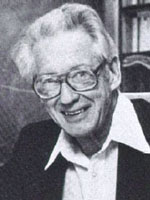
Robert W. Parry
University of Utah
Organized Skepticism
I went to my first Gordon Research Conference in 1951 at the New Hampton School in New Hampshire. I had just obtained my Ph.D. under John Bailar and had started working as a faculty member at the University of Michigan. Bailar did very important work in coordination chemistry and, along with Fred Basolo and Conard Fernelius, helped revive the discipline of inorganic chemistry in the United States. Fernelius was the head of the chemistry department at Pennsylvania State University; he worked with coordination compounds and organized the first Inorganic Chemistry GRC. He wanted to include young faculty at the conference, and so he invited me.
As it turned out, my first conference was a rough experience. I was fresh out of graduate school and working on a project involving boron hydrides, but I did not yet have conclusive results. I hypothesized that boron hydrides would act like coordination compounds with a hydride ion–instead of chloride or fluoride–hooked to the boron. But the compound called the “diammoniate of diborane” posed a structural problem. I thought it might be similar to coordination compounds, and I decided to present the idea without having the data to prove it. There was a lot of evidence supporting my theory, but because my presentation was still all speculation, the other researchers ate me alive. I presented an unproven hypothesis, which was not what GRC attendees expected to hear.
Motivated by that experience, I completed my research four years later and produced evidence to show I was right. I demonstrated that one could systematically replace hydride ions with NH
3 molecules around the central boron molecule, BH
4-. That allowed us to find group III (boron, aluminum, and gallium) compounds that were structurally and behaviorally similar to the metal coordination compounds developed by Alfred Werner in the 1890s.
For many years boron hydrides were considered anomalies because they had only three valence electrons, yet they formed such compounds as B
2H
6 and B
4H
10, whose formulas were identical to the carbon compounds C
2H
6 and C
4H
10. However, the carbon atoms of these compounds each had four valence electrons. The boron compounds were specially named “electron-deficient compounds” because they had only three conventional bonding electrons per central atom, and the multicentered two-electron bond was added to chemical theory of the period to explain bonding in boron hydrides and other electron-deficient species. (The current theory also works well for “electron-deficient atoms.”) Today electron-deficient compounds are an important component of modern chemistry: they form a bridging group between the metals and the more conventional two-center bonded organic groups, and many of them are excellent catalysts. In today’s nomenclature these compounds contain “multicenter bonds."
Collegial skepticism was one of the most endearing features of the Gordon Conferences. If presenters had data to support their work, they could quiet the opposition; if not, they were open to questions and criticism. At the Inorganic Chemistry Conference, attendees could interrupt each other to ask a question. But the basic ground rule was that you were on your own: if you made a statement and someone wanted to question you, your answer could not be “because I say so.” In all the talks I gave after my first GRC, I was very sure I had data to back up my statements.
There were many other opportunities for researchers to speak to each other at Gordon Conferences. Starting with the conferences on Gibson Island, sessions were offered in the morning and at night, leaving the afternoons free. Attendees loved having the free time: it gave rise to a lot of talk about chemistry. One of the wonderful things about the conference was the “trapped” group of excellent researchers with whom you could talk and argue. The experience is very different from an American Chemical Society meeting, where you spend ten minutes talking to presenters after they have given a talk and then one of you has to run off before you can get to know them or their science well. But if you spend an afternoon in a boat together, you discuss topics of mutual personal and scientific interest.
Photo courtesy Special Collections Department, J. Willard Marriott Library, U. of Utah.